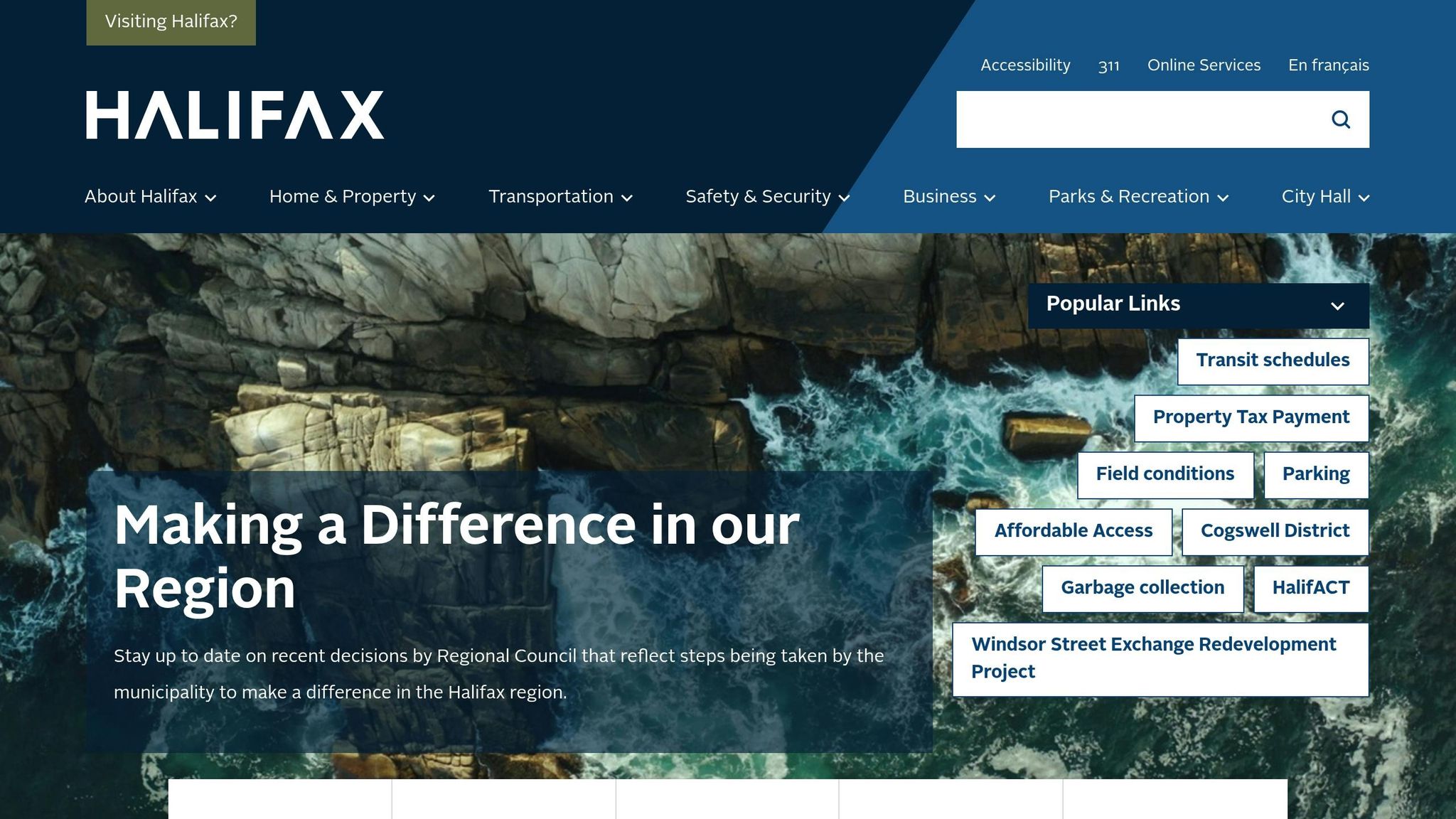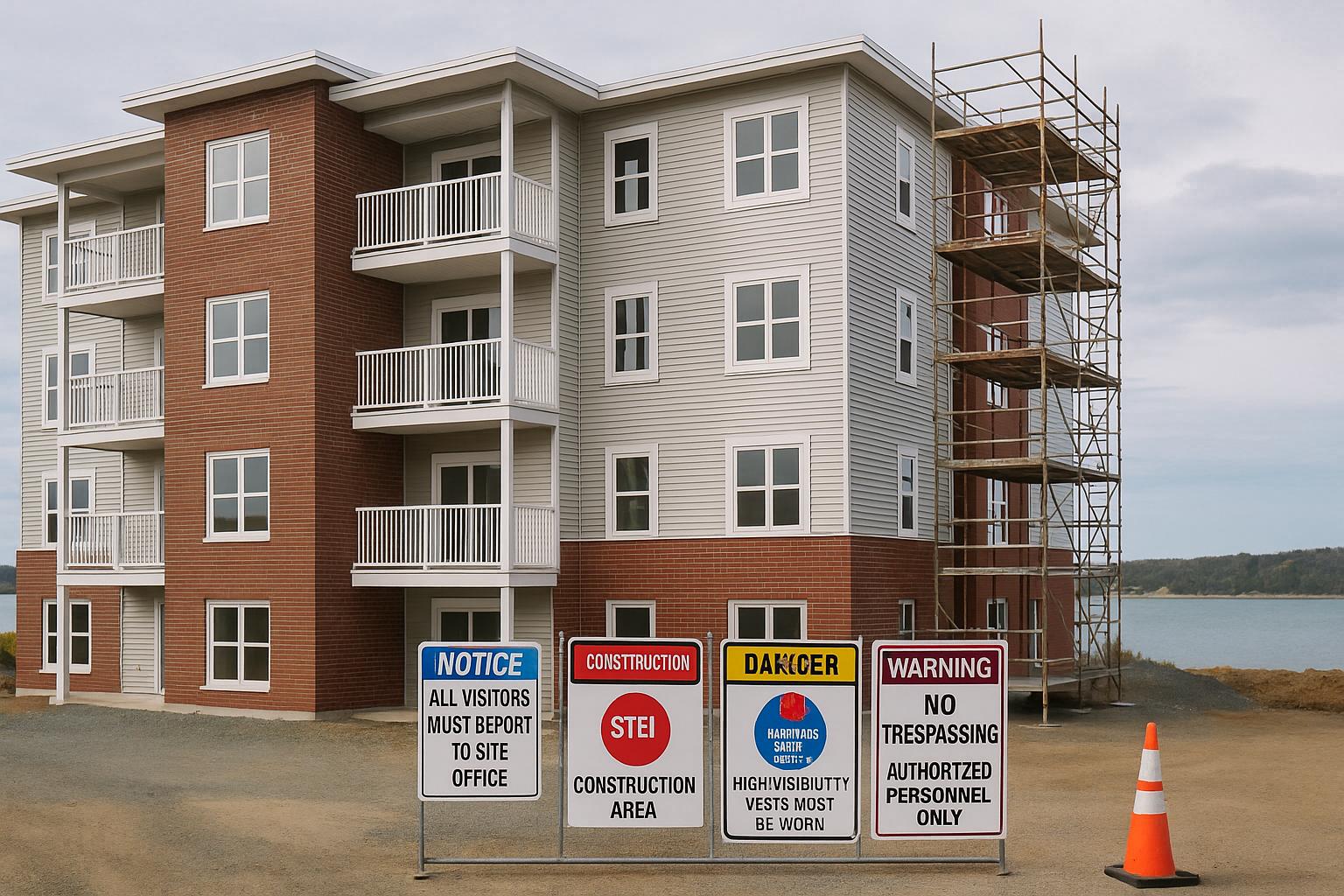Developing multi-unit rental properties in Halifax Regional Municipality (HRM) involves strict rules that can affect timelines and budgets. Key areas to address include:
- Tree Protection: Detailed vegetation maps are required, and removing trees without approval can lead to fines.
- Watercourse Setbacks: Construction must maintain specific distances from water bodies, with boundaries determined by professional surveys.
- Stormwater Management: Developers need engineered systems to manage runoff, preventing flooding and erosion.
- Site Assessments: Environmental studies may be required, especially on previously disturbed land, to address contamination.
Ignoring these rules can result in fines, redesigns, and delays. Early planning, expert consultations, and adherence to HRM’s regulations can help keep projects on track and within budget.
HRM Tree Bylaws and Urban Forest Protection

In Halifax Regional Municipality (HRM), multi-unit residential developments must adhere to land use by-laws designed to protect existing vegetation. As part of the permitting process, site plans need to clearly outline the location and condition of vegetation on the property. Proper documentation of this vegetation early in the process is crucial, as it plays a key role in meeting municipal requirements and avoiding delays. The steps involved in this documentation process are discussed in more detail below.
Vegetation Documentation in Site Plans
Creating accurate vegetation maps is not just a formality - it’s a practical tool that helps municipalities assess the site more efficiently. These maps can streamline the review process, ensuring that everything moves forward without unnecessary interruptions.
Potential Impacts of Incomplete Vegetation Details
If vegetation details are incomplete or unclear, it often leads to requests for revisions. These additional requests can slow down the approval process, stretching out project timelines and inflating budgets. Delays like these can ripple through the construction schedule, making it critical to get the documentation right from the start. To avoid these kinds of setbacks, it’s wise to incorporate compliance measures early in the planning phase.
Strategies for Compliance
Here are some practical steps to ensure compliance with HRM’s vegetation-related by-laws:
- Use the Interactive Property Information map: This tool helps you understand the specific land use by-laws that apply to your property.
- Consult with local permitting experts: Professionals familiar with HRM’s processes can help verify that your site plans accurately reflect existing vegetation.
- Start documenting vegetation early: Including this step in the initial design stages can reduce the likelihood of needing costly or time-consuming modifications later.
Watercourse Setbacks and Riparian Zone Rules
Just like HRM's vegetation rules, watercourse setbacks demand careful consideration from the very start of your planning process. These setbacks create buffer zones around water bodies - such as streams, rivers, lakes, and wetlands - where construction is restricted. Getting familiar with these rules early can save you from expensive redesigns or poor site choices. Below, we break down what setbacks are, how to identify watercourse boundaries, and how to make the most of your buildable space.
What Watercourse Setbacks Are and Why They Matter
Watercourse setbacks are the minimum distances that structures must maintain from water bodies. In HRM, these distances vary depending on the type of watercourse and the area’s environmental sensitivity. The purpose of these setbacks is to protect the natural functions of watercourses and preserve the surrounding environment. Factors like the size of the watercourse, soil conditions, and local slopes all play a role in determining the required setback.
How to Identify Watercourse Boundaries on Your Property
Pinpointing watercourse boundaries isn’t as straightforward as it might seem. These boundaries are "ambulatory", meaning they can shift over time due to natural factors like erosion, flooding, or seasonal water level changes [1]. To ensure compliance with regulations, you’ll need an accurate legal description of the boundary, which typically requires professional surveys and environmental assessments. Relying on outdated surveys or visual estimates simply won’t cut it.
Professional surveyors use advanced tools and standardized methods to map out watercourse boundaries accurately. This ensures that any planned structures meet current setback requirements.
Making the Most of Buildable Space Within Setback Limits
Once you’ve established your property’s watercourse boundaries, strategic planning can help you maximise your buildable area. Thoughtful site design can allow you to comply with setback rules while still creating a functional, multi-unit development. Instead of just avoiding watercourses, consider designs that actively improve the environment. HRM may be open to approving projects that enhance water quality, boost wildlife habitats, or support biodiversity [2].
Engaging landscape architects or environmental consultants early in the process can help you identify ways to work within setback limits while maintaining compliance. These experts can also suggest strategies to prevent increases in base flood elevation, ensuring your project aligns with both environmental and regulatory expectations.
Stormwater Management and Lot Grading Rules
In Halifax Regional Municipality (HRM), stormwater management rules add another layer of complexity to multi-unit development projects. These regulations dictate how water flows across your site during and after construction, influencing everything from building placement to site design - and ultimately, your project budget. Getting a handle on these requirements early can save you from costly redesigns and ensure your development is ready to handle Halifax's heavy rainfall and seasonal weather conditions. Below, we’ll explore key design considerations and budgeting factors you need to know.
Stormwater Retention and Drainage Requirements
HRM mandates that developers manage stormwater runoff on-site using systems like retention basins, infiltration methods, and detailed drainage plans. These measures aim to prevent flooding, curb erosion, and protect nearby properties from excessive water flow. Municipal stormwater infrastructure - such as culverts, pipes, ditches, and catch basins - is overseen by Halifax Water, meaning your project must connect to these systems without overwhelming them.
The specific design of stormwater systems depends on factors like the size and slope of your site, soil conditions, and how close you are to existing infrastructure. Engineers are tasked with creating systems that meet HRM’s standards while integrating seamlessly with the municipal drainage network. Recently, HRM has been exploring nature-based solutions for large-scale projects, offering insights for smaller developments. A great example is the "Shore Road: Building with Nature" project in Eastern Passage. Launched in February 2023 and led by Victoria Fernandez Martinez, a stormwater and coastal resiliency engineer, this $5 million initiative demonstrates how thoughtful stormwater management can tackle multiple environmental challenges at once [3].
Engineering Costs for Stormwater Compliance
Budgeting for stormwater compliance means accounting for engineering fees tied to the design and implementation of these systems. The complexity of the work depends heavily on your site’s characteristics, including its slope, drainage patterns, and proximity to watercourses.
The Shore Road project in Eastern Passage highlights the scale and timeline involved in stormwater engineering. With a total cost of $5 million - $3 million of which was funded by Infrastructure Canada - the project required extensive design work and modelling. The design phase is expected to wrap up by Fall 2024, with tenders issued in Winter 2024/25 and construction slated for Spring/Summer 2025 [3].
For smaller developments, early consultation with skilled engineers is essential. By addressing stormwater management during the initial stages of site design, you can make informed decisions about building placement and site layout. This proactive approach not only helps streamline the approval process but also minimizes the risk of costly redesigns down the road.
sbb-itb-16b8a48
Site Assessments and Contamination Protocols
Site assessments play a crucial role in HRM multi-unit projects. Knowing when these evaluations are necessary and how to handle potential contamination can save property owners time and prevent costly delays.
When Site Assessments Are Required
HRM often mandates environmental studies, particularly in areas with a history of industrial or other impactful land use[5]. To determine if your property needs an assessment, consult municipal planning documents and connect with local government officials early in the planning phase. This proactive approach can help you identify requirements and streamline the approval process.
Dealing with Contamination During Development
Should a site assessment uncover contamination concerns, it’s critical to act swiftly. Collaborate with environmental specialists, local planning authorities, and a real estate lawyer to outline remediation steps and ensure compliance with zoning regulations[4].
Incorporating these evaluations into your initial due diligence will help keep your project on track and minimize disruptions.
Building Environmental Compliance into Your Development Process
To navigate the evolving regulatory landscape, it's essential to incorporate environmental compliance into the earliest stages of your planning. Recent examples, like the province's rejection of Halifax's new regional plan in August 2025 and Halifax Water's updated 2025 Design Specifications, underline how quickly regulations can shift. Being proactive and sequencing tasks properly can help keep your projects on schedule[6][9].
Timing Approvals and Surveys
Before finalizing your designs, prioritize environmental surveys and assessments. Schedule critical evaluations like tree surveys, watercourse boundary assessments, and site contamination studies well ahead of submitting development applications. Halifax Water requires professional engineers to certify compliance for system extensions, so booking these consultations early is key[9]. This ensures your designs remain flexible and avoid unnecessary setbacks.
Once these surveys are complete, the next step is working with experts to interpret and act on the findings.
Working with Environmental Experts
Start by identifying the specific Land Use By-law (LUB) that applies to your area, as environmental rules vary across different plan areas within HRM[7]. Bringing in arborists and environmental consultants early allows you to address HRM-specific requirements from the outset. It's also important to collaborate with professionals familiar with Halifax Water's stormwater management requirements under By-Law G-200[8].
Involving experts early reduces the risk of costly redesigns and helps you maintain better control over your budget.
Preventing Costly Redesigns and Delays
Understanding alternative approval paths can help you navigate setback constraints. For instance, the rejected regional plan included provisions for development agreements that allowed building within watercourse buffer zones[6].
Incorporate environmental considerations into your site planning from the start. Strategically place buildings and parking areas to maximize usable space without relying on variances or exemptions. Planning ahead not only avoids compliance issues but also keeps costs predictable. Professional engineering reviews, stormwater management systems, and tree preservation measures are expenses you can account for early, rather than dealing with unexpected costs during construction.
Finally, choose builders who are well-versed in HRM’s environmental requirements. Effective coordination between environmental consultants, engineers, and construction teams ensures that compliance is seamlessly integrated into the construction process, avoiding delays caused by miscommunication or siloed efforts.
Key Points for HRM Environmental Compliance
When tackling multi-unit projects in HRM, prioritizing environmental compliance from the start can save both time and money. Here's what you need to keep in mind:
- Tree Protection is Non-Negotiable: HRM has strict rules about tree preservation. Removing trees without approval can lead to fines and extra expenses. Design your project to work around existing trees and make sure to get the necessary permits early.
- Watercourse Setbacks: Identify all watercourses on the property - including seasonal streams - right from the beginning. This will help you meet local setback requirements and avoid complications later.
- Stormwater Regulations: Bring engineers on board early to address stormwater management. This proactive approach can help you stay compliant and keep costs under control.
- Contamination Assessments: If the property has a history of disturbances, conduct contamination assessments as early as possible. This will help you avoid unexpected delays and additional remediation costs.
- Environmental Surveys: Schedule surveys for trees, watercourses, and potential contamination early in the process. This allows you to make necessary design adjustments and steer clear of costly delays.
- Experienced Builders: Choose builders who are familiar with HRM's environmental regulations. Their expertise can streamline the approval process and help ensure compliance.
FAQs
What happens if I don't follow HRM's tree protection and watercourse setback rules when building a multi-unit property?
Non-compliance with HRM's tree protection and watercourse setback rules can lead to serious consequences. These include fines, project delays, and even legal action, all of which can drive up costs and throw off your construction timeline.
Ignoring these regulations might also result in mandatory site remediation, adding further strain to your budget and schedule. To steer clear of these setbacks, it's essential to follow HRM's guidelines from the very beginning. Working with professionals who understand local regulations can help ensure your project stays on track.
What are the best ways to manage stormwater runoff in HRM to meet environmental regulations and control project costs?
Managing stormwater runoff in the Halifax Regional Municipality (HRM) demands a careful mix of meeting environmental rules and staying within budget. To align with HRM's watercourse setbacks and stormwater management standards, consider using low-impact development (LID) techniques like rain gardens, permeable paving, and green roofs. These approaches not only cut down on runoff and enhance water quality but can also speed up the approval process.
Collaborating with experts familiar with HRM's bylaws and environmental requirements is crucial. They can help you incorporate stormwater solutions into your site plans early on, saving you from expensive revisions or project delays. On top of that, tools like stormwater modelling software can offer precise predictions of runoff impacts, allowing you to make smart choices, stay compliant, and manage costs effectively.
Why are site contamination assessments important for multi-unit projects in HRM, and what should you do if contamination is discovered?
Site contamination assessments play a key role in multi-unit projects within the Halifax Regional Municipality (HRM). They ensure the property is safe for development and meets all environmental regulations. These assessments are essential for identifying potential risks, such as contaminated soil or groundwater, which could endanger future tenants, construction crews, or the surrounding area.
When contamination is detected, the first step should be to consult an environmental specialist. They can assess the scope of the problem and create a remediation plan tailored to the situation. Depending on the severity, this plan might include actions like removing, treating, or containing the affected soil. Tackling these issues early on can save time, reduce unexpected expenses, and help avoid regulatory fines.



